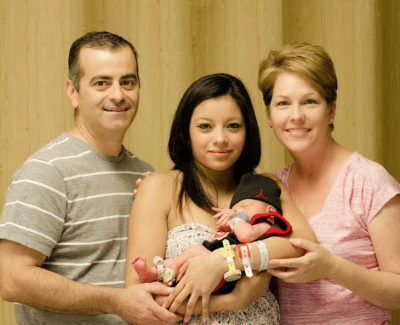An Introduction to Unique Adoptions
 Adoption is a situation that brings families together with a focus on love and care. There are many individuals who are involved in making it a success, and if they can work through a single point of contact, then the process is made much easier.
Adoption is a situation that brings families together with a focus on love and care. There are many individuals who are involved in making it a success, and if they can work through a single point of contact, then the process is made much easier.
That’s what we do at Unique Adoptions. We have a caring and respectful team that provides dependable and professional service to all parties involved. Our personal approach means we get to know everyone in the adoption and give them specialized and ongoing support throughout the process.
No one gets lost along the way in our services, as they might at large agencies. We are a nationwide adoption facilitator that lives up to the meaning of facilitate. We help bring about an outcome, in this case, a successful adoption. Our team works with birthmothers and adoptive parents to create new and happy families.
We have a great deal of experience in creating new families. Whether you are a birthmother looking for a loving home for your infant or a family looking to grow and share the love you have to give, we can help.
Our team has nationwide adoption facilitator skills that you can call on to help you through an adoption anywhere in the country.
Steps for a Successful Adoption Process
 When you set out on the adoption journey, it’s an exciting time as you wait to add a new member to your family. The steps along the way can’t be rushed, but the process is made smoother and easier to understand by working with an adoption facilitator like the team at Unique Adoptions.
When you set out on the adoption journey, it’s an exciting time as you wait to add a new member to your family. The steps along the way can’t be rushed, but the process is made smoother and easier to understand by working with an adoption facilitator like the team at Unique Adoptions.
Once you’ve decided the time is right for you to adopt a child, you need to consider what type of adoption is best for your family. Are you going to adopt an infant, adopt a child from foster care, or pursue an international adoption?
At Unique Adoptions, we are an adoption facilitator that provides service throughout the U.S., and we work hand-in-hand with licensed adoption agencies worldwide. We offer this blog post to give you an idea of the steps that are encountered along the way to adopting a child.
Once you’ve settled on the type of adoption that best suits you, it’s time to complete a home study, which includes paperwork, obtaining clearances, and in-person interviews. Then, you wait for a referral that matches you with a birthmother if that is the route you’ve chosen. If you adopt from foster care, you are in contact with the child during the process, but still have to wait to go through the steps up to placement.
Once you welcome the newest addition to your family, go slowly, as the adjustment curve is a steep one. Slow and steady wins the race.
Who Holds the Power in Adoption: Birth Mothers or Adoptive Parents?
 The relationship between birth mothers and adoptive parents is complicated for many reasons. One factor is the tension in the power dynamics at play. Adoptive parents sometimes feel like the expectant parents “hold all the cards” before the adoption. An adoption facilitator is sometimes helpful at this stage as a buffer, providing a communication conduit between the two parties. But after the adoption is formalized, the power balance shifts in favor of the adoptive parents, with birth mothers often acutely and painfully aware of their lack of power. Emotions run high, and the adoption facilitator is no longer in the picture. This imbalance of power adds a layer of complication to an already complex relationship.
The relationship between birth mothers and adoptive parents is complicated for many reasons. One factor is the tension in the power dynamics at play. Adoptive parents sometimes feel like the expectant parents “hold all the cards” before the adoption. An adoption facilitator is sometimes helpful at this stage as a buffer, providing a communication conduit between the two parties. But after the adoption is formalized, the power balance shifts in favor of the adoptive parents, with birth mothers often acutely and painfully aware of their lack of power. Emotions run high, and the adoption facilitator is no longer in the picture. This imbalance of power adds a layer of complication to an already complex relationship.
Fear of Being Judged
Often, birth mothers feel some understandable insecurity and worry about being judged. They end up walking on eggshells, feeling that they have to be as close to perfect as possible or adoptive parents won’t let them be in their children’s lives after the adoption facilitator is gone.
The fear of being judged can become a self-fulfilling prophecy — a loop the adoptive parents/birth parent relationship cannot break. If birth mothers are open with their child’s adoptive parents about how they feel, it may be positive for the relationship. Ideally, if adoptive parents listen to these fears with empathy and understanding, the relationship may grow and improve over time.
Four Tried and True Tips for a Smooth Transition Home with Adopted Kids
 It is often true that the first few months with newly adopted children can be a challenge for both the child and the family as a whole. For those considering adoption, this can be the largest initial concern. Take heart. There are several tips for easing the transition to your home for newly adopted older children.
It is often true that the first few months with newly adopted children can be a challenge for both the child and the family as a whole. For those considering adoption, this can be the largest initial concern. Take heart. There are several tips for easing the transition to your home for newly adopted older children.
If you are considering adoption, here are a few tips to consider, which may help ease your worries about the transition process when adopting an older child.
Take it Slow
Taking it slow can be tricky with international adoptions, but try to slow down wherever possible. Start visitations in the child’s foster home or orphanage, and then move visitations to a neutral space, such as a park. Spend time getting to know your new child. Finally, move visitations to your home.
Ask Questions About Her or His Past
If you’re considering adoption, what questions would you want to know about your potential new child? Read the child’s complete file; not just the summary. Obtain as much information as possible on the child’s past life. Learn as much as you can.
Do Some Investigation
Talk with the orphanage or the foster family and ask questions about routines, likes, dislikes, etc. If you are traveling abroad to pick up your child, consider stocking up on her favorite food to bring home.
Be Flexible
Set your expectations very low concerning the first couple of months. A great day is just one where everyone gets fed and survives. Things will improve as everyone settles in and acclimates.
Facing Your Fears During the Adoption Process
 Adding a new member to your family is very exciting. Along with that excitement, there are often many concerns and worries. Questions and fears may arise from the unknown. That is completely understandable, and it’s natural to feel that way. At Unique Adoptions, we’ve helped many, many families through the process as a nationwide adoption facilitator, and we’re going to provide advice on facing your fears at this time.
Adding a new member to your family is very exciting. Along with that excitement, there are often many concerns and worries. Questions and fears may arise from the unknown. That is completely understandable, and it’s natural to feel that way. At Unique Adoptions, we’ve helped many, many families through the process as a nationwide adoption facilitator, and we’re going to provide advice on facing your fears at this time.
The first thing you need to remember that will give you strength is you are not alone. You have support and resources, such as our team, you can call upon. Sure, you may be worried about being up to the task of becoming a parent, but that’s the norm for anyone in any situation. It’s a wonderfully positive, life-changing event, but it’s also a very major one. Remember that you can and will adapt, and before long, it will be the most natural thing in the world for you.
Confront your fears head-on. Learn as much as you can on the issues you are worried about, and that will give you the confidence to move forward with the tools you need. For example, some children may have health issues, but if you reach out to a nationwide adoption facilitator for assistance, you will have the skills and knowledge that will help you cope.
It’s natural to be afraid; but remember, you’re not alone.
5 Practical Tips for Healthy Open Adoption Relationships
 The key to a positive adoption experience is what’s best for the child. With that in mind, at Unique Adoptions, we would like to tell you that open adoptions have been shown by research to be beneficial for the child.
The key to a positive adoption experience is what’s best for the child. With that in mind, at Unique Adoptions, we would like to tell you that open adoptions have been shown by research to be beneficial for the child.
These types of adoptions are now the norm in the US, with interactions between the birth family and adoptive family ranging from in-person visits to an exchange of photos and letters through a third-party. We are going to provide five tips here that will help you navigate the waters of open adoptions.
- Keep the child front and center because they are the entire reason you’re doing this.
- Take advantage of resources, such as education and counseling. It will help you calm any fears you may have about keeping the birth family as part of your child’s life.
- Discuss with the birth family what level of openness you want and what they want. An adoption facilitator can help you with these discussions so you can find common ground.
- Strive to create a healthy, respectful relationship with the birth family.
- Look for assistance and support when you need it to handle conflicts or feelings of anger toward the birth family.
This is an unusual experience for everyone involved, but with patience and professional support, you can make your way through it successfully.
Dealing with the Unknowns in Adoptive Parenting
 Adoption is a pathway to joy for countless parents around the world. It can also be a journey full of unknowns and unexpected challenges. Like any parent, you’ll find yourself out of your depth and without a plan in many situations, and you’ll need the right mindset to make the best choices for yourself and your new child. Your adoption facilitator can help with many issues, and a few key tips help you be prepared to deal with the unfamiliar.
Adoption is a pathway to joy for countless parents around the world. It can also be a journey full of unknowns and unexpected challenges. Like any parent, you’ll find yourself out of your depth and without a plan in many situations, and you’ll need the right mindset to make the best choices for yourself and your new child. Your adoption facilitator can help with many issues, and a few key tips help you be prepared to deal with the unfamiliar.
Focus on What You Know — If you’ve had kids before, you already have lessons you have learned from. If not, you’ve certainly gone through intensive training as part of the adoption process. Use the skills and resources available to you when you need them, and understand your kids as people.
Communicate — If you’re feeling uncertain, your child is definitely lost. It’s okay to go through it together. The more you talk and connect, the easier it is to navigate the best path forward for everyone involved.
Get Backup — Remember that adoption facilitator? The organization you work with likely has many resources and advice for new parents. Likewise, nonprofits and state agencies offer an abundance of information and assistance when you feel like you need a little help.
Coping with the Emotional Turmoil of Giving up a Baby for Adoption
 For parents who aren’t ready or in the right place to have a child, giving it up for adoption is one of the bravest and most selfless acts in the world. Even so, it often comes with an emotional toll that isn’t easy to cope with on your own. When you need advice, compassion, or just a place to share your experience free from judgment, a birthmothers’ support group can help.
For parents who aren’t ready or in the right place to have a child, giving it up for adoption is one of the bravest and most selfless acts in the world. Even so, it often comes with an emotional toll that isn’t easy to cope with on your own. When you need advice, compassion, or just a place to share your experience free from judgment, a birthmothers’ support group can help.
These collectives provide a platform and community for women experiencing the complex intersections of responsibility, loss, and connection that come with the adoption process. They can be a source of support and validation, as well as a tether to others that understand the things you feel on a personal level.
If you’ve never been part of a birthmothers’ support group, joining one might sound intimidating. Fortunately, the facilitators specialize in making new faces feel welcome. Most importantly, you’re among people who recognize the awesome responsibility of making tough choices like yours. That alone can help you heal, find peace, and move forward confidently to live your best life. It’s an opportunity that you’ve sacrificed to provide for a child. The next step is giving yourself the same chance to flourish with the right support.
Tips to Prepare Children for the Adoption of a Sibling
 Welcoming a new member to your family is always an exciting time. If you already have children, then it goes without saying that everyone will have to make some adjustments in their lives. Your adoption facilitator has provided a few tips that can be helpful as adoption day draws near.
Welcoming a new member to your family is always an exciting time. If you already have children, then it goes without saying that everyone will have to make some adjustments in their lives. Your adoption facilitator has provided a few tips that can be helpful as adoption day draws near.
First, Be Upfront with Your Children
One of the first things you will need to do is to tell your children about their new adopted sibling as soon as possible. This means being upfront about what is going on, and also talking about it frequently. Allow them to be excited about having a new brother or sister, and also take the time to listen to their feelings.
At the same time, it is also important for your children to prepare for the experience of having an adopted sibling. You should anticipate that your children will get questions from other children and adults about their mismatched family. Allow them to practice what to say in these situations. Doing so will reinforce your shared values as a family while upholding a sense of privacy.
Anticipate That There Will Be Growing Pains
If you are welcoming a toddler to your family and your children are about the same age, then you will need to anticipate that adjustment will be rocky. The new child might have had past experiences that forced them to compete for attention, and there will be times where such episodes are a distinct possibility.
In these cases, you need to assure your child that such behaviors are inappropriate for your home. Additionally, teach your child to foster an accepting environment for their new sibling. Assure your child that you are committed to sharing your love and attention.
Raising children can be challenging, especially when adopted siblings are entering the picture. However, being honest and straightforward can go a long way in easing this period of transition. Your adoption facilitator may also have more suggestions about working out relationships between children.
Choosing Adoption Does Not Make You a “Bad” Mother
 Placing a child for adoption can be one of the hardest decisions you will ever make as a mother. A choice like this will inevitably make you ask questions about yourself, and it is natural to feel this way. Through all this, it is important to know that choosing adoption does not make you a “bad” mother–in fact, it’s quite the opposite.
Placing a child for adoption can be one of the hardest decisions you will ever make as a mother. A choice like this will inevitably make you ask questions about yourself, and it is natural to feel this way. Through all this, it is important to know that choosing adoption does not make you a “bad” mother–in fact, it’s quite the opposite.
Choosing adoption demonstrates that you are doing what is best for your child, and that’s as far away from being a “bad” parent as possible. You are doing everything you can to ensure your child will have the life and opportunities they deserve.
Sacrifice Makes Way for a Brighter Future
Choosing to place your child up for adoption is not an easy decision. As your child is adopted by a loving family who is prepared to provide for them, you might find that you are losing a part of yourself. However, a good mother places their children’s needs above their own, and choosing adoption proves that you want what is best for your child.
The truth of the matter is that raising a child is expensive and that costs will only increase over time. If you aren’t ready to become a parent, then keeping the baby might subject them to financial troubles for life. There is no shame in letting a better-prepared couple adopt and raise your child. You are giving a new life the chance to flourish and that is one of the biggest acts of love you can ever express to someone.
There is also a chance that you can still have a relationship with your child. Adoption is no longer treated as the taboo it once was. In fact, open adoptions are becoming commonplace. You can make arrangements to meet with your child periodically and still be a part of their life.
Placing your child for adoption is a big decision, and it won’t come quickly. However, recognizing your limitations and doing what is best for the baby is one of the greatest things you can do as a mother. If you are considering adoption, be sure to get in contact with an adoption facilitator to discuss the process.
The Different Adoption Services for Birthmothers
 Putting a baby up for adoption can be a challenging moment in your life. You may be under physical or emotional stress, and you may be wondering what the future may hold–both for you and your child. However, many adoption services for birthmothers are available to you. In this article, we will go over the different types of adoptions from which you can choose.
Putting a baby up for adoption can be a challenging moment in your life. You may be under physical or emotional stress, and you may be wondering what the future may hold–both for you and your child. However, many adoption services for birthmothers are available to you. In this article, we will go over the different types of adoptions from which you can choose.
Your Adoption Options
In many cases, as the birthmother, you will make the major decisions about how the adoption will go. You can work with an agency to find an adoptive family. This process includes interviewing candidates to see if they might be a good fit for your child. After choosing the family, the next step in adoption services would be to pick the type of adoption. There are three categories:
Closed: A closed adoption is exactly what it sounds like. After putting your child up for adoption, you will not be able to contact the child or the adoptive family.
Semi-Open: The adoptive family may give you periodic updates about your child. This is often done through e-mail, through an intermediary like an adoption lawyer or adoption agency.
Open: This is the most common form of adoption. It allows you to remain in contact with the child and the adoptive family. You can work with the adoptive family to set up a communication plan, as well as visits with the child.
When thinking over your options for adoption, always think about what is best for the child. While the decision you are making might feel heavy, you can feel hope in knowing you are giving the best possible opportunities for a better life to your son or daughter. You can always consider consulting with a professional to learn more about adoption services for birthmothers.
Matching a Birthmother with an Adoptive Family
 Putting a child up for adoption isn’t an easy decision to make. However, doing so will present a child with the best possible opportunities to live their life. If you are thinking of putting your child up for adoption, know that you can turn to a birthmother’s adoption program.
Putting a child up for adoption isn’t an easy decision to make. However, doing so will present a child with the best possible opportunities to live their life. If you are thinking of putting your child up for adoption, know that you can turn to a birthmother’s adoption program.
After deciding that adoption is the best route to take for you, the next step is to find the right family for the child. Here is a brief overview of the family matching process.
The Process at a Glance
First things first: as a mother, you get the final say about how the adoption process will proceed. You get to decide the family who gets to raise your child, meaning you will always have a say in how the adoption will go. With that in mind, you will begin the process of contacting an adoption agency, which will then assign you a caseworker to participate in the adoption program.
The caseworker will work with you to find prospective families. You can narrow the pool of candidates by stating preferences for ethnicity, marital status, financial history, employment, and personality, among other factors. Then, you will review adoption candidates by meeting with them, getting to know what they are like, and more.
After picking the adoptive parents, you will then have the choice of setting up the type of adoption you would like. There are three types: closed, semi-open, and open. These options will define how often you will communicate with your child and whether you can visit them.
You don’t have to work through adoption alone. People are here to help. Consult with us to learn more about the birthmother’s adoption program.
What to Expect During Your Adoption Home Study
 The home study is a part of the adoption process that may seem overwhelming for some. Many feel uncomfortable with a stranger coming into their home and assessing their potential to successfully raise a child. The home study is slightly different from what most people think, but it is completely normal to feel a little anxious. It’s a good idea to ask detailed questions to your adoption facilitator, but here is a general idea of the process, so you can know what to expect:
The home study is a part of the adoption process that may seem overwhelming for some. Many feel uncomfortable with a stranger coming into their home and assessing their potential to successfully raise a child. The home study is slightly different from what most people think, but it is completely normal to feel a little anxious. It’s a good idea to ask detailed questions to your adoption facilitator, but here is a general idea of the process, so you can know what to expect:
Gathering Materials
An adoption facilitator or social worker will ask you to collect various documents, such as birth certificates and marriage licenses. The purpose here is to ensure the potential adoptive parent or parents are who they claim to be. Health and financial records are also examined for validity.
Interviews With Members of the Household
Each member of the household in which the child would be living will be interviewed. The goal here isn’t to scare anyone but to learn about the dynamics within the household. This step may seem daunting, but an adoption facilitator will explain that it is simply due diligence to ensure that your household is a good fit for a potential child.
Home Visits With Social Workers
A social worker will visit a potential home at least once. They will not inspect every inch of a home; they are merely ensuring the space is suitable for a child.
Background Checks
Typically, the documents collected earlier in the process are used to verify the potential adoptive parents’ backgrounds. Adoption facilitators help explain that this to ensure there are no prior domestic violence charges or child abuse reports.
Character References
One of the last steps of the process is collecting character references. A social worker will go through the friends and family of potential adoptive parents to take character references and get a better idea of who they are.
Tips For Keeping in Communication with Your Child’s Birthmother
 Birth mothers who have opted open adoptions may not be able to care for their child the way they feel is optimum, but still want to watch them grow and have some involvement in their lives, and this wish should be respected by adoptive parents as it is in the child’s best interests. Maintaining positive, consistent communication in a way that respects the rights of both adoptive parents and birth parents may be tricky sometimes, but not impossible. A birthmothers adoption program of communication can help.
Birth mothers who have opted open adoptions may not be able to care for their child the way they feel is optimum, but still want to watch them grow and have some involvement in their lives, and this wish should be respected by adoptive parents as it is in the child’s best interests. Maintaining positive, consistent communication in a way that respects the rights of both adoptive parents and birth parents may be tricky sometimes, but not impossible. A birthmothers adoption program of communication can help.
Here are three ideas adoptive parents can use when communicating with the birthmothers of their children.
Face to Face
Meeting in person is ideal as it allows more personal communication; however, it can also pose some challenges. Finding a time that fits everyone’s schedules can be difficult. This may limit visitations and introduce frustration when schedules do not line up well.
You should try to project positivity and openness when speaking with the birth parents and note if their body language shows discomfort.
Phone Calls, Texts, and Emails
A birthmothers adoption program may include phone calls, texts, and emails as they allow for greater flexibility. Although these options increase access, it is important to still respect boundaries that may have been agreed upon. Excessively frequent or untimely messages can place stress on relationships.
Social Media
Social media provides another avenue to communicate with birth parents. By following your account, they will be able to see the pictures and stories that you, as parents, are excited to share. This can help the birth parents to feel included and is a very convenient way to improve consistent, stress-free contact.
|
|
|
|

